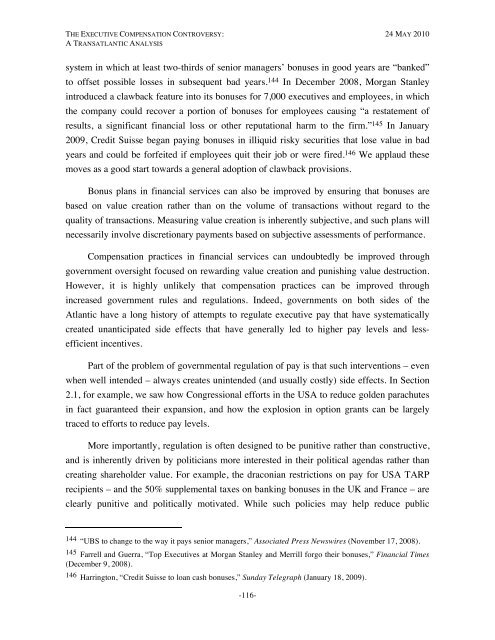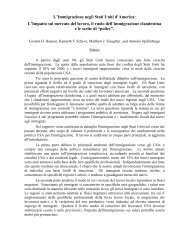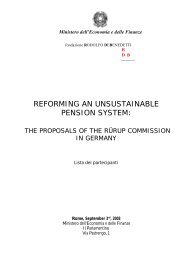The Executive Compensation Controversy - Fondazione Rodolfo ...
The Executive Compensation Controversy - Fondazione Rodolfo ...
The Executive Compensation Controversy - Fondazione Rodolfo ...
You also want an ePaper? Increase the reach of your titles
YUMPU automatically turns print PDFs into web optimized ePapers that Google loves.
THE EXECUTIVE COMPENSATION CONTROVERSY: 24 MAY 2010A TRANSATLANTIC ANALYSISsystem in which at least two-thirds of senior managers’ bonuses in good years are “banked”to offset possible losses in subsequent bad years. 144 In December 2008, Morgan Stanleyintroduced a clawback feature into its bonuses for 7,000 executives and employees, in whichthe company could recover a portion of bonuses for employees causing “a restatement ofresults, a significant financial loss or other reputational harm to the firm.” 145 In January2009, Credit Suisse began paying bonuses in illiquid risky securities that lose value in badyears and could be forfeited if employees quit their job or were fired. 146 We applaud thesemoves as a good start towards a general adoption of clawback provisions.Bonus plans in financial services can also be improved by ensuring that bonuses arebased on value creation rather than on the volume of transactions without regard to thequality of transactions. Measuring value creation is inherently subjective, and such plans willnecessarily involve discretionary payments based on subjective assessments of performance.<strong>Compensation</strong> practices in financial services can undoubtedly be improved throughgovernment oversight focused on rewarding value creation and punishing value destruction.However, it is highly unlikely that compensation practices can be improved throughincreased government rules and regulations. Indeed, governments on both sides of theAtlantic have a long history of attempts to regulate executive pay that have systematicallycreated unanticipated side effects that have generally led to higher pay levels and lessefficientincentives.Part of the problem of governmental regulation of pay is that such interventions – evenwhen well intended – always creates unintended (and usually costly) side effects. In Section2.1, for example, we saw how Congressional efforts in the USA to reduce golden parachutesin fact guaranteed their expansion, and how the explosion in option grants can be largelytraced to efforts to reduce pay levels.More importantly, regulation is often designed to be punitive rather than constructive,and is inherently driven by politicians more interested in their political agendas rather thancreating shareholder value. For example, the draconian restrictions on pay for USA TARPrecipients – and the 50% supplemental taxes on banking bonuses in the UK and France – areclearly punitive and politically motivated. While such policies may help reduce public144 “UBS to change to the way it pays senior managers,” Associated Press Newswires (November 17, 2008).145 Farrell and Guerra, “Top <strong>Executive</strong>s at Morgan Stanley and Merrill forgo their bonuses,” Financial Times(December 9, 2008).146 Harrington, “Credit Suisse to loan cash bonuses,” Sunday Telegraph (January 18, 2009).-116-









